

Binding problem. The binding problem is a term used at the interface between neuroscience, cognitive science and philosophy of mind that has multiple meanings.

Firstly, there is the segregation problem: a practical computational problem of how brains segregate elements in complex patterns of sensory input so that they are allocated to discrete "objects". In other words, when looking at a blue square and a yellow circle, what neural mechanisms ensure that the square is perceived as blue and the circle as yellow, and not vice versa? The segregation problem is sometimes called BP1. Secondly, there is the combination problem:The problem of how objects, background and abstract or emotional features are combined into a single experience.[1] The combination problem is sometimes called BP2. However, the difference between these two problems is not always clear.
The segregation problem[edit] Definition[edit] Experimental work[edit] Synchronization theory[edit] Feature integration theory[edit] Definition[edit] Neural binding - Wikipedia. Neural binding involves the complex coordination of diverse neural circuits A viable mechanism for this phenomenon must address (1) the difficulties of reconciling the global nature of the participating (exogenous) signals and their relevant (endogenous) associations, (2) the interface between lower perceptual processes and higher cognitive processes, (3) the identification of signals (sometimes referred to as “tagging”) as they are processed and routed throughout the brain, and (4) the emergence of a unity of consciousness.
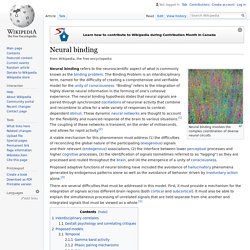
Proposed adaptive functions of neural binding have included the avoidance of hallucinatory phenomena generated by endogenous patterns alone as well as the avoidance of behavior driven by involuntary action alone.[3] Interdisciplinary correlates[edit] The study of the binding problem in neuroscience stems from the much older psychological study of the binding phenomenon, which has its roots in the ancient philosophical study of the same problems.
Proposed models[edit] The Neuroscience of Bass: New Study Explains Why Bass Instruments Are Fundamental to Music. Photo by Sebastiaan term Burg via Wikimedia Commons At the lower range of hearing, it’s said humans can hear sound down to about 20 Hz, beneath which we encounter a murky sonic realm called “infrasound,” the world of elephant and mole hearing.

But while we may not hear those lowest frequencies, we feel them in our bodies, as we do many sounds in the lower frequency ranges—those that tend to disappear when pumped through tinny earbuds or shopping mall speakers. Since bass sounds don’t reach our ears with the same excited energy as the high frequency sounds of, say, trumpets or wailing guitars, we’ve tended to dismiss the instruments—and players—who hold down the low end (know any famous tuba players?).
In most popular music, bass players don’t get nearly enough credit—even when the bass provides a song’s essential hook. What is Déjà Vu? - Frontiers for Young Minds - Scientific American Blog Network. You can find the original article highlighted here published at Frontiers for Young Minds.

(Teale J and O’Connor A (2015) What is Déjà vu?. Front Young Minds. 3:1. doi: 10.3389/frym.2015.00001) Déjà vu describes the strange experience of a situation feeling much more familiar than it should. Young people experience déjà vu the most. Are Implanted False Memories Permanent? No memories are permanent.

In fact, recent understanding is that no memory is actually factual. When we recall a memory, it's as if our brain pulls up a report and outlines it to our consciousness, which subsequently relives it, usually incorporating slight inaccuracies, and the recollection is stored along with the original - and we can't tell the difference between them. Our brains deliberately make us forget things, to prevent insanity.
Even People With “Perfect Memory” Can Be Tricked Into Recalling Fake Events. When neurons misfire: Those who can remember what they ate for lunch on a day ten years ago can be fooled by tests that distort memories.
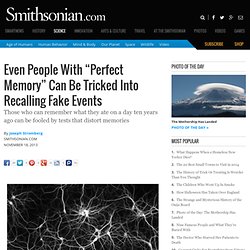
Image via razorsmile Among us mortals who forget where we just left our keys and what we ate for lunch yesterday, there are a handful of remarkable people with hyperthymesia—also known as highly superior autobiographical memory (HSAM)—who can remember astounding details about every day of their life going back to childhood. Given any particular date in the last few decades, Brad Williams can remember both what he did that day and what significant world events occurred. So it’s true! The full Moon does mess with our sleep. On the three or four nights surrounding a full moon, it took the participants five minutes longer to fall asleep, and they slept for 20 fewer minutes.

Their EEG activity, which measured NREM sleep, fell by 30%. Their melatonin levels were lower and they reported feeling less rested the following day. All of them? Really? Or just the whole group on average? Memory implantation is now officially real. In this study, the mouse is now afraid of an environment in which it never received pain, and would therefore not associate pain with it.
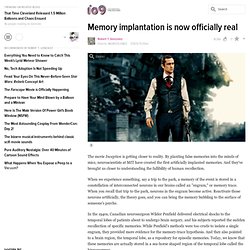
By artificially activating the neurons associated with the pain-free environment in a new context with a foot shock, a fear response is now elicited the original context where no shock or pain occurred. The experiment takes advantage of associations, but uses optogenetic activation to make the mouse remember shock where shock never occurred (false memory).
But the environment could be similar enough that it thinks it may be get a shock anyways. umm, yeah, but the mouse still recieved pain from simply thinking of or remembering the environment. Imagine it this way. People in a vegetative state may feel pain - health - 23 February 2013. IT IS a nightmare situation.
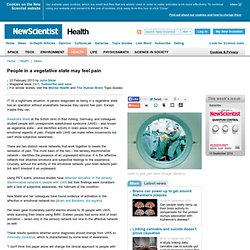
A person diagnosed as being in a vegetative state has an operation without anaesthetic because they cannot feel pain. Except, maybe they can. Alexandra Markl at the Schön clinic in Bad Aibling, Germany, and colleagues studied people with unresponsive wakefulness syndrome (UWS) – also known as vegetative state – and identified activity in brain areas involved in the emotional aspects of pain. People with UWS can make reflex movements but can't show subjective awareness. There are two distinct neural networks that work together to create the sensation of pain. Now Markl and her colleagues have found evidence of activation in the affective or emotional network too (Brain and Behavior, doi.org/kfs).
Her team gave moderately painful electric shocks to 30 people with UWS, while scanning their brains using fMRI. These results question whether some diagnoses should change from UWS to minimally conscious, which is characterised by some level of awareness. New Interface Allows Humans to Move a Rat’s Tail With Their Thoughts. Trending on Related Blogs The Final Fantasy XV Problem 811 people reading on Kotaku The Stubborn "Nail Houses" That Refuse to Get Demolished 780 people reading on Gizmodo Why Deadspin Sucks, By Former NFL Punter Chris Kluwe 665 people reading on Deadspin.
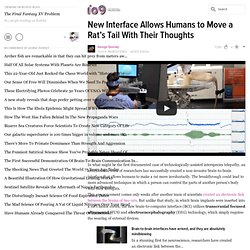
The First Successful Demonstration Of Brain-To-Brain Communication In Humans. Hyperbolic Orange and the River to Hell. The River Styx. A river whose blue is as dark as black… The tumultuous stygian blue currents claw at the underbelly of Phlegyas’ vessel. Writhing with distorted faces of the sullen, its inky blackness belongs only in nightmares. A blue that has no place in the natural world. Video: The High-Resolution Life of a Neuron. The activity of a single neuron is captured in unprecedented detail by this footage, which is so fine-grained that individual proteins can be seen shuttling in and out.
Captured on microscope and illuminated by bioluminescent proteins, the video represents a methodological improvement that allows imagers to focus on individual pathways inside the cell. That prevents overlapping pathways from being simultaneously and confusingly illuminated. The study describing the method was published in July in Cell Reports. Video: Bioluminescent proteins illuminate the activity of a single neuron. (Arnold et al. Decision-Making and Control in the Brain. Damage to the brain's frontal lobe is known to impair one's ability to think and make choices. And now scientists say they've pinpointed the different parts of this brain region that preside over reasoning, self-control and decision-making.
Researchers say the data could help doctors determine what specific cognitive obstacles their patients might face after a brain injury. For the study, neuroscientists at the California Institute of Technology (Caltech) examined 30 years worth of data from the University of Iowa's brain lesion patient registry and mapped brain activity in almost 350 people with lesions in their frontal lobes. They linked these maps with data on how each patient performed in certain cognitive tasks. Researchers show that memories reside in specific brain cells. Our fond or fearful memories — that first kiss or a bump in the night — leave memory traces that we may conjure up in the remembrance of things past, complete with time, place and all the sensations of the experience. Neuroscientists call these traces memory engrams. But are engrams conceptual, or are they a physical network of neurons in the brain? In a new MIT study, researchers used optogenetics to show that memories really do reside in very specific brain cells, and that simply activating a tiny fraction of brain cells can recall an entire memory — explaining, for example, how Marcel Proust could recapitulate his childhood from the aroma of a once-beloved madeleine cookie.
False memories generated in lab mice - life - 22 March 2012. Why does falling asleep sometimes feel like falling down? Infinity Imagined. Infinity Imagined. Infinity Imagined. The 4 Biggest Myths About the Human Brain. Perhaps a wrinkle to your summary? Not quality or quality - structure. Our neurons aren't fundamentally 'higher quality' than a rodent's; the nature of neuron scaling implies a difference in the way they are packed, and their pattern of connectivity. Requiring more space, a rodent's brain must be filling with 'other stuff' quickly - perhaps glial tissue, for rapid response time despite a larger brain=longer processor cycles?
Primates may be more contemplative, with a few, well-trimmed, long-dendrite neurons slowly linking abstract thoughts. Equating our intelligence with necessary forms in machine intelligence conflates two problems: understanding our own cognition, and developing models and machines to solve the problems we can't or won't. Next question: Nature is only able to explore those structures and functions which appear in the environment, and can only move to the adjacent possible.
If we remember more, can we read deeper–and create better? Part II. Is memory essential for creativity? Image credit: Philip Bitnar / Koukej Makak Production 2010, Creative Commons. How many calories does thinking burn? Why The Left-Brain Right-Brain Myth Will Probably Never Die. Why Some People Can Recall Life's Every Moment. Can you remember what you ate for lunch on March 8, 1999?
What about what you were wearing on Oct. 29, 1985? If we remember more, can we read deeper–and create better? Part I. The genes behind human intelligence also made us vulnerable to autism. Humans Evolved Big Brains to Be Social? How Our Brains Make Memories. Is Your Brain Liberal Or Conservative? The political differences between liberals and conservatives might run as deep as the brain, researchers suggest.
Scientists had previously found that some psychological traits were associated with certain political views. Neuroscientists identify a master controller of memory. My connectome, myself. The human brain has 100 billion neurons, each of which is connected to many others. Neuroscientists believe these connections hold the key to our memories, personality and even mental disorders such as schizophrenia. More Facebook Friends Means Bigger Brain Areas, U.K. Study Finds. Oct. 19 (Bloomberg) -- People who have more Facebook friends have more gray matter in their brains, a finding that may spur further research on the relationship between social networking and the mind, U.K. researchers said.
A strong correlation was found between the number of Facebook connections and the amount of gray matter, or brain tissue responsible for processing signals, according to research led by Geraint Rees, a senior clinical research fellow at University College London. The Facebook Brain. Brain Study Points to Potential Treatments for Math Anxiety - Inside School Research. For some students, an announcement of a math pop quiz can send them into a cold sweat. Where Fear Lives: Fighting Against Post-Traumatic Stress. The neural and cognitive correlates of aimed throwing in chimpanzees: a magnetic resonance image and behavioural study on a unique form of social tool use.
Allen Institute for Brain Science - Welcome. Annie Murphy Paul: What we learn before we're born. Sebastian Seung: yo soy mi conectoma. Your brain chemistry existed before animals did - life - 01 September 2011. A short film about the monkey head transplant experiment of the 1960s. The Midnight Archive - A. Head B. Body. Brain's synaptic pruning continues into your 20s - health - 17 August 2011.
A brief history of the brain - life - 26 September 2011. Instant Expert: Memory. Banishing consciousness: the mystery of anaesthesia - health - 29 November 2011. Can't find your keys? Your brain's out of sync - health - 30 January 2012. Why harmony pleases the brain - physics-math - 19 September 2011. Zoned-out rats may give clue to consciousness - life - 12 October 2011. Why free will may be an illusion. Near-death experiences may be triggered by serotonin - health - 08 September 2011. Card trick reveals the subconscious mind is on watch - life - 16 November 2011. Your brain's family album, from hydra to human - Image 1. Eyes reveal true hypnotic state for the first time. Hyperactive neurons build brains in synaesthesia - health - 17 November 2011. Infinity Imagined. Clint Eastwood helps reveal secrets of brain evolution - health - 05 February 2012.
First brain movie captures a mouse thinking. Neuroglia. Infinity Imagined. Infinity Imagined. Infinity Imagined. Neurosphere.